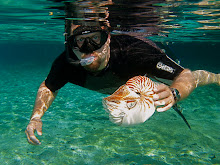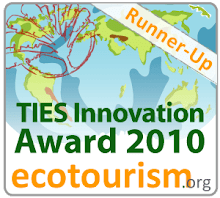 |
| The islands of (the not so) Secret Bay of Raja Ampat |
This past February Oceanic Society fielded its inaugural group on the famed Raja Ampat liveaboard the Pindito. The Pindito pioneered underwater exploration in the region and has been one of its longest active leaders in working to promote marine conservation. We were a group of 13 avid snorkelers excited to be spending 12 days exploring the most biodiverse tropical reef ecosystem on the planet, the Bird’s HeadSeascape. Accompanying our group was cetacean researcher Benjamin Kahn. Benjamin is based in Bali and has been studying the whales of the coral triangle for over a decade. One of Benjamin's main research interest are the Indo-Pacific migratory corridors of east Indonesia, Papua New Guinea and the Solomon Islands; and the importance of these narrow yet deep passages for large migratory marine life such as Blue and Sperm whales.
 |
| Snorkeler in Raja Ampat above lush Soft Corals |
Our
group charter was going to provide him with valuable research time in the
Raja Ampat waters, where we would spend the mornings and afternoons snorkeling
and then the mid-day surveying for cetaceans. Benjamin has been doing these
surveys alongside divers for the last 4 years, but we were his first group of
snorkelers. Over the years Benjamin has observed more than 12 species (of the
30 present in the Coral Triangle) of cetaceans in Raja Ampat, and on a few
occasions the groups have even managed to get in the water with the whales.
These opportunities to have long days out on the water provide valuable data
points for Benjamin about where whales are found in these areas and more
importantly, how they are using them. Through the use of directional
hydrophones and dedicated deck top observation time we were able to spot
multiple groups of whales over the days we were there. The clang of the ship bell
and the yell of “blow” punctuated many of our afternoons.
Something that makes the Coral Triangle a unique area in
addition to the marine biodiversity found there (over 450 species of coral,
1750 species of fish) is the fact that it has so much deep water habitat
adjacent to shallow water habitat. In fact, almost 85% of the Coral Triangle
waters are over 200m in depth, therefore you find exceptional marine diversity
with high overlap of near shore and deep sea habitats. Benjamin is using these
sighting efforts to identify whale hotspots in the area and look to see how
these hotspots overlap with development plans. In order to properly conserve
and regulate the marine protected areas within the Coral Triangle it is vital
to understand how things like shipping lanes and potential extractive
industries development may overlap with whale migration corridors.
Our days on the Pindito were full of exciting snorkeling
opportunities along multiple islands, and many afternoons having intimate
encounters with Bryde’s and Sperm whales as well as many species of dolphin.
 |
| Map of our groups journey over the 12-day voyage |
The additional benefit of dedicating some of our afternoons to whale surveys
was that we also had saw many other animals that we might have missed had we
just been motoring through. During these times we saw sailfish and manta rays
jumping, marine turtles, and large bait balls that were attracting multiple
seabird species.
 |
| Manta seen jumping during whale survey efforts |
Our group had truly
wonderful experiences and at the same time was able to substantially contribute
to the conservation research of the region.
 |
| Bumphead Parrotfish schooling |




No comments:
Post a Comment